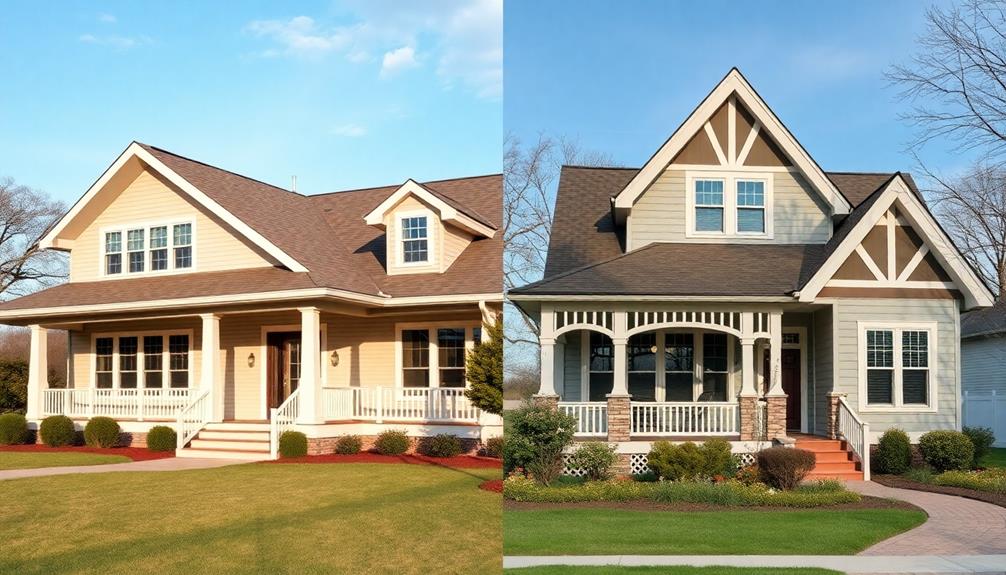When you're choosing between ranch houses and bungalows, consider their distinct styles and layouts. Ranch homes offer spacious, open-concept designs with ample natural light and privacy through separate bedrooms. They're perfect for families who love entertaining. Bungalows, on the other hand, boast cozy, compact interiors with unique architectural charm and efficient use of space, making them ideal for those who appreciate intimacy and accessibility. Each style has pros and cons that cater to different preferences. If you're curious about how these features impact your lifestyle, keep exploring to discover more insights.
Key Takeaways
- Ranch houses feature open-concept designs with spacious layouts, ideal for families and entertaining, while bungalows offer compact, intimate spaces for efficient living.
- Bungalows typically boast one or one-and-a-half stories, enhancing accessibility and warmth, compared to the sprawling single-story ranch designs.
- Ranch homes have large windows that connect interiors with nature, whereas bungalows emphasize cozy alcoves and unique architectural features for charm.
- Lower heating and cooling costs make ranch houses economical, while bungalows align with modern sustainability practices and efficient use of space.
- Both styles reflect cultural contexts: ranch houses symbolize post-war suburban expansion, while bungalows celebrate craftsmanship from the Arts and Crafts movement.
Architectural Characteristics

When considering architectural characteristics, you'll find that ranch houses and bungalows embody distinct design philosophies. Ranch houses showcase low-pitched roofs, spacious patios, and horizontal lines that create a modern aesthetic. Their large windows and high ceilings contribute to an airy feel, while wide overhanging eaves provide shade and style.
In contrast, bungalows prioritize compactness and efficient space use, often featuring steeply pitched roofs and vertical elements. They highlight cozy alcoves, custom attic spaces, and decorative touches like exposed rafters, offering a traditional charm.
Both styles reflect their historical backgrounds and design principles, catering to various aesthetic preferences. Your choice between a ranch house and a bungalow will ultimately depend on which architectural elements resonate with you more.
Layout and Interior Features

The architectural characteristics of ranch houses and bungalows naturally lead to differences in their layout and interior features. Ranch houses boast open-concept designs that enhance natural light while providing separate bedrooms for privacy. High ceilings create an airy feel, ideal for family gatherings.
In contrast, bungalows focus on compact layouts that maximize space. You'll often find built-in shelving and efficient storage solutions, making every square foot count. Cozy alcoves and charming verandas add to the inviting atmosphere.
Both styles cater to different lifestyle needs—ranch houses are perfect for families seeking space, while bungalows appeal to those desiring intimacy and comfort. Ultimately, your choice depends on how you want to live and what fits your personal style.
Pros and Cons Comparison

Choosing between a ranch house and a bungalow involves weighing the pros and cons of each style.
Ranch houses offer spacious layouts with open-concept designs, perfect for families and entertaining. They typically feature lower heating and cooling costs, making them economical in the long run. However, their larger footprint may require more maintenance and landscaping.
On the other hand, bungalows provide cozy, intimate spaces with efficient layouts that maximize every square foot. They're easier to maintain due to their single-story design, making them great for those who prefer accessibility.
Yet, their compact nature might feel cramped for larger families. Ultimately, your choice should reflect your lifestyle needs and personal preferences, as both styles have unique advantages and challenges.
Bungalows vs. Traditional Houses

Bungalows stand out from traditional houses by offering a unique blend of charm and practicality. Unlike traditional homes, which often feature multiple stories and varied layouts, bungalows are typically one or one-and-a-half stories. This design creates an intimate atmosphere, perfect for those who value cozy living spaces.
You'll find bungalows prioritize efficient use of space with built-in shelving and compact storage solutions, making them ideal for budget-conscious buyers. Additionally, their energy efficiency aligns well with modern sustainability practices, which is essential for today's environmentally conscious homeowners, as seen in building and legal considerations.
While traditional houses can encompass a wide range of styles, they often lack the same sense of warmth and accessibility that bungalows provide. Understanding these distinctions can help you choose a home that suits your lifestyle, ensuring you enjoy both comfort and functionality in your living environment.
Ranch House Appeal

Ranch houses have a unique appeal that draws many homebuyers in. Their spacious layouts and modern designs create an inviting atmosphere that suits a variety of lifestyles.
Here are some features that make ranch homes stand out:
- Open-concept layouts that enhance natural light flow
- Low-pitched roofs providing a sleek, modern look
- Large windows that offer views of the outdoors
- Separate bedrooms ensuring privacy for family members
- Wide overhanging eaves adding to the architectural charm
These characteristics make ranch houses particularly attractive to families and those who value space and efficiency.
Whether you're entertaining guests or enjoying quiet family time, ranch homes provide the perfect backdrop for a comfortable lifestyle.
Bungalow Advantages

With their charming designs and practical layouts, bungalows offer several advantages that appeal to many homeowners.
First, their compact interiors make efficient use of space, perfect for those who prefer a cozy atmosphere. You'll appreciate the seamless flow between rooms, which enhances social interactions and everyday living.
Bungalows also feature lower profiles, making them easily accessible for people of all ages. With fewer stairs to navigate, maintenance becomes simpler, saving you time and effort.
Natural light pours in through large windows, creating a bright, welcoming environment. Additionally, their unique architectural elements often add character and charm, making bungalows a desirable choice for buyers looking for a home that feels both intimate and inviting.
Cultural Context of Housing

Housing styles often reflect the cultural values and historical backgrounds of the communities they belong to. Housing styles often reflect the cultural values and historical backgrounds of the communities they belong to. For instance, american and european home design showcase distinct aesthetics and architectural principles that highlight their unique traditions and lifestyles. While European homes often feature timeless elegance with intricate details and stonework, American homes tend to emphasize functionality and open spaces, reflecting a more modern and versatile approach.
When you consider ranch and bungalow houses, you'll see how each style embodies distinct cultural narratives:
- Ranch houses symbolize post-war optimism and suburban expansion.
- Bungalows illustrate the Arts and Crafts movement, focusing on craftsmanship.
- Regional adaptations showcase local materials and climate considerations.
- Both styles respond to lifestyle needs, such as family dynamics or urban living.
- Architectural choices often reveal socio-economic factors influencing homeownership.
Frequently Asked Questions
What Are the Historical Origins of Ranch Houses and Bungalows?
Ranch houses originated in the 1920s, inspired by Spanish colonial architecture. Bungalows emerged in the early 20th century, influenced by Arts and Crafts movement ideals, emphasizing simplicity and craftsmanship, reflecting unique cultural influences.
How Do Climate and Location Influence the Choice Between These Styles?
When you consider climate and location, you'll find they greatly influence your choice. Ranch houses thrive in spacious areas, while bungalows suit urban settings, adapting to local weather and maximizing comfort in tight spaces.
Are There Eco-Friendly Options for Ranch and Bungalow Designs?
Imagine planting a garden; eco-friendly designs for ranches and bungalows can thrive similarly. You can incorporate solar panels, green roofs, and energy-efficient materials, ensuring your home nurtures both the environment and your living space.
What Is the Average Cost of Building a Ranch vs. a Bungalow?
When you're considering building costs, ranch houses typically range from $150 to $200 per square foot, while bungalows often cost between $100 and $175. Your final price will depend on location and materials chosen.
How Do Maintenance Requirements Differ Between Ranch Houses and Bungalows?
When it comes to maintenance, ranch houses usually require less effort due to single-story designs, making access easier. Bungalows, with their compact spaces, might need more attention to detail in upkeep and repairs.
Conclusion
In the end, choosing between a ranch and a bungalow is like deciding between a cozy hug and an open embrace. Both styles offer unique charms that can reflect your lifestyle and preferences. Whether you lean towards the spacious freedom of a ranch or the intimate comfort of a bungalow, remember that your home should be a sanctuary—your very own Garden of Eden. So, weigh your options and find the style that speaks to your heart the most.









